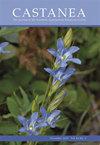1989年“雨果”飓风后蒲illum变种延龄草的长期人口学研究
IF 0.3
4区 生物学
Q4 PLANT SCIENCES
引用次数: 1
摘要
摘要飓风雨果是1989年9月的一场五级风暴,通过风力破坏和风暴潮泛滥,严重影响了卡罗莱纳州沿海平原的自然区域。弗朗西斯·贝德勒森林是位于四孔沼泽的奥杜邦野生动物保护区,其森林树冠遭到严重破坏。为了应对人们对罕见的春季短命延龄草(Trillium pusillum var.pusillum)可能会因混合硬木树冠的损失而受到负面影响的担忧,我们在1990年春天建立了永久性地块,由城堡的生态学系师生记录了单叶、三叶和开花个体。森林树冠的破坏将显著改变森林地面的微生境条件,对T.pusillum var.pusillum种群数量产生负面影响。预计飓风“雨果”和树冠覆盖的丧失不会对人口产生负面影响。有证据表明,冠层覆盖率的降低和光照的增加与开花的增加有关。在29年的种群监测中,变异系数作为衡量不同年份群体变异性的指标,从开花到三叶,再到小叶都有所增加。前两三年命名风暴的数量与小叶植物的数量之间存在显著的正相关。尽管开花个体的数量已经减少,但没有证据表明种群数量正在减少。这项长期人口统计的结果表明,即使是飓风和热带风暴等严重的自然扰动,也可能对延龄草种群动态产生积极影响。本文章由计算机程序翻译,如有差异,请以英文原文为准。
Long-term Demography Study of Trillium pusillum var. pusillum Following Hurricane Hugo in 1989
ABSTRACT Hurricane Hugo was a category five storm in September of 1989 that significantly impacted natural areas along the Carolina coastal plain through wind damage and storm surge flooding. Francis Beidler Forest, an Audubon wildlife sanctuary in Four Holes Swamp, suffered severe damage to its forest canopy. In response to concerns that the rare spring ephemeral Trillium pusillum var. pusillum may be negatively impacted by the loss of the mixed hardwood canopy, we established permanent plots in the spring of 1990 with single leaf, triple leaf, and flowering individuals recorded by Ecology faculty and students at The Citadel. Disruption to the forest canopy would significantly alter forest floor microhabitat conditions negatively affecting T. pusillum var. pusillum population demography. There was no expected negative effect of Hurricane Hugo, and the loss of canopy cover on the population. Evidence suggests that the decrease in canopy cover and increased light was associated with increased flowering. The coefficient of variation, as a measure of cohort variability among years, increased from flowering, to triple leaf, to single leaf across the 29 years of population monitoring. There was a significant positive association between the number of named storms in the previous two and three years and the number of single leaf plants. There was no evidence that the population is decreasing, even though the number of flowering individuals has decreased. The results of this long-term demography suggest that even severe natural disturbances, like hurricanes and tropical storms, may have a positive effect on Trillium population dynamics.
求助全文
通过发布文献求助,成功后即可免费获取论文全文。
去求助
来源期刊

Castanea
生物-植物科学
CiteScore
0.50
自引率
25.00%
发文量
28
审稿时长
>12 weeks
期刊介绍:
Castanea is named in honor of the American Chestnut tree. Castanea is thebotanical name for Chestnuts, dating back to what the ancient Greeks calledthem.
The American Chestnut is a critically endangered tree that once made up 35%of the forests of the Eastern US before being devastated by a blight thatdestroyed up to 4 billion American Chestnut trees.
Castanea serves professional and amateur botanists by reviewing andpublishing scientific papers related to botany in the Eastern United States.
We accept papers relating to plant biology, biochemistry, ecology, floristics,physiology and systematics.
 求助内容:
求助内容: 应助结果提醒方式:
应助结果提醒方式:


